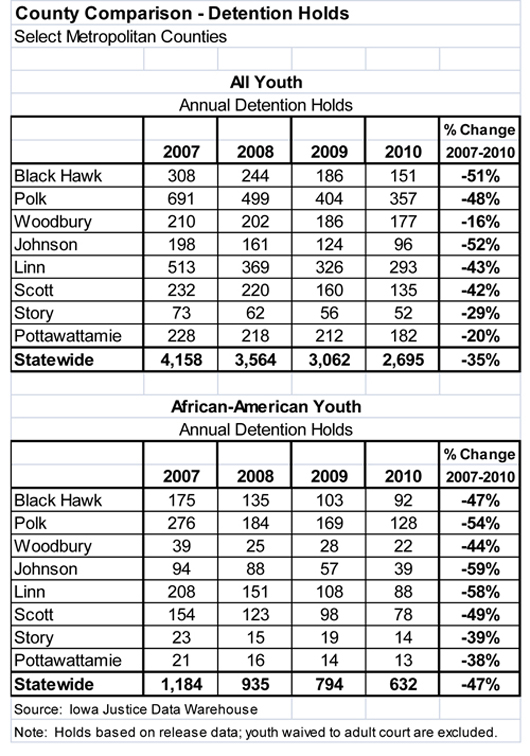Iowa Sees Significant Reduction in Youth Detention
Iowa has reduced its detention holds, defined as incidents of release, by 47% for African-American youth and by 35% for all youth since 2007, an accomplishment state officials say has gotten a major boost from the introduction of JDAI that year.
 “These are the most dramatic detention reductions Iowa has seen in the last 20 years,” said Duane Hoffmeyer, chief judge of Iowa’s Third Judicial District Court. “That we have been able to nearly halve our detention holds for African-American youth without compromising public safety makes it all the more noteworthy.”
“These are the most dramatic detention reductions Iowa has seen in the last 20 years,” said Duane Hoffmeyer, chief judge of Iowa’s Third Judicial District Court. “That we have been able to nearly halve our detention holds for African-American youth without compromising public safety makes it all the more noteworthy.”
Iowa’s state-level JDAI activities have included the use of a state oversight committee, implementation of a single detention-screening instrument utilized in three local sites, and the analysis of local detention data. “We’ve been able to allocate resources for the regular provision of data,” said Paul Stageberg, administrator for the Department of Human Rights, Division of Criminal and Juvenile Justice Planning.
“The ability for the sites to monitor their progress has been an important part of this work. That’s been a key aspect of the reductions.”
JDAI operates in Black Hawk, Polk, and Woodbury counties, said Stageberg. Black Hawk and Polk have reduced holds for Caucasian and African-American youth by 50% or more, he said. Woodbury has reduced holds for African-American youth by 44%. Stageberg attributed the local JDAI success to strong collaborations and leadership, consistent staff support, and the willingness to utilize local detention alternatives.
“I’ve appreciated the framework and structure that we’ve had from the JDAI model,” said David Gleiser, local coordinator in Woodbury County.
The county has taken advantage of information and tools from the trainings and technical assistance, he said. It has also benefited from the experiences of other sites as it struggled through various implementation issues. “It’s then a matter of taking advantage of the resource information through the Casey consultants or the JDAI Help Desk,” said Gleiser.”
Non-JDAI counties such as Johnson, Linn, and Scott counties are experiencing reductions similar to those in the JDAI counties, said Stageberg. He noted that in 2007, Juvenile Court Services began implementing a comprehensive risk/needs-assessment instrument, the Iowa Delinquency Assessment (IDA), on youth at intake and petition. Some jurisdictions are utilizing risk scores from the IDA to screen detention admissions, he said.
“Utilization of the IDA, implementation of local best practices, including Functional Family Therapy and Aggression Replacement Training, as well as other local detention alternatives have all contributed to detention reductions,” said Stageberg. “We think the JDAI effort and the state-level activities have provided a good push, but it’s clear that efforts beyond JDAI are contributing as well. We’re pleased to have the numbers going in the right direction.”






